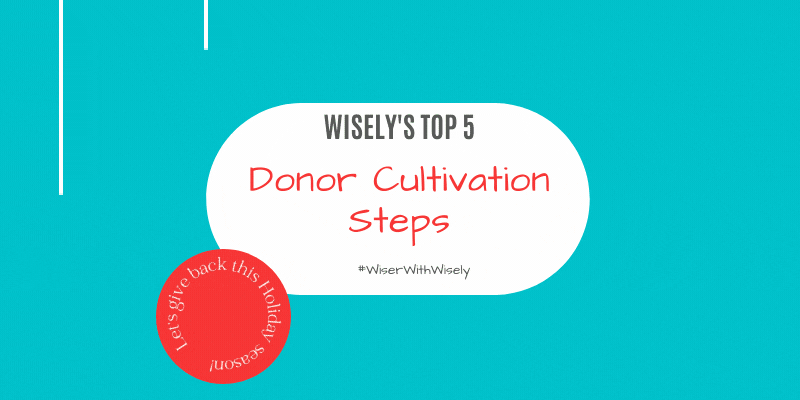
Throughout December we’re sharing a collection of Wisely’s Top 5 to help set your fundraising team up for success in the new year! This week we’re sharing Wisely’s top 5 Donor Cultivation Steps.
Donor Cultivation is an important part of the donor lifecycle, during this stage you are getting to know your donors and prospects and building a relationship with them. Remember: strong donor relationships lead to more revenue for your nonprofit.
1. Qualify Prospects
At first glance, this might not seem like a cultivation step, but ensuring that the prospects you’re going to cultivate are qualified is really important. When you have limited time available for cultivation of current major gift donors and new prospects you need to make sure you’re focusing on the right people and not chasing dead ends.
What to consider when qualifying a prospect:
- Do they have the financial capacity to donate at the major gift level?
- Are they interested in your nonprofit’s mission and programming?
- Is now the right time for the prospect to make a gift?
Your fundraising portfolio can help a lot with qualifying prospects against your set criteria and tracking your outreach.
2. Build a Case for Support
One of the main components of donor cultivation is introducing prospects to your nonprofit’s mission and work – and how donations support this work. To do this effectively and consistently your fundraising team needs to have a case for support.
A case for support is a document that tells donors and prospects about your nonprofit, your mission and the problems you’re trying to solve, key programs, and how donations help.
Here are some ideas to include in your case for support:
- Background information on your mission including statistics
- How your nonprofit is solving these issues
- Beneficiary success stories to show impact
- Information on programs and how donations help
When you have a case for support ready you can bring it to donor meetings or send it out in the mail as a follow-up for donors and prospects to review.
3. Introduce Yourself
The first thing you have to do to cultivate donor and prospect relationships is to introduce yourself and your nonprofit’s mission. There are a variety of ways you can do this, and how you reach out will vary from donor to donor.
Here are some practical ways to introduce yourself:
- Send an email, this is a quick way to reach out to donors to schedule a call or a meeting – and it offers the donor flexibility to respond in their own time
- Pick up the phone to call donors and introduce yourself
- Schedule an in-person or virtual introduction meeting, a meeting will give you the opportunity to get into details and really get to know your donor
Once you’ve introduced yourself and gotten to know the donor a little bit, you can decide how to best continue to cultivate that relationship, your fundraising portfolio can help by tracking next steps.
4. Record All of Your Actions
Recording the actions you take in your CRM during donor cultivation is how you will keep track of who you’ve reached out to. It’s also how you’ll know when it’s time to move a prospect from cultivation into solicitation.
This is an important step for building your fundraising portfolio and your gift pipeline because the notes you take donor outreach will inform how many donors you think will make a gift and when. If you’re using Wisely for your fundraising portfolio it makes it really easy to track cultivation steps with checklists. Wisely’s AI insights can use this information and predict donor behaviour.
5. Analyze Results
Donor Cultivation is relationship focused and can be very fluid. So it can be difficult to judge your fundraising team’s performance. But when you’re spending so much time on donor outreach, you should make sure that what you’re doing works!
Here are a few ways you can measure the results of your cultivation work:
- The number of proposals your fundraising team sends out – this will show how many prospects were moved to solicitation
- The number of accepted proposals shows if your cultivation efforts created a strong enough bond to result in a donation
- Proposal results – did donors end up giving less than the proposed donation amount, did they give more
Your fundraising portfolio can help you with analyzing results by tracking and measuring the success of your cultivation. Use your portfolio to track when you send out proposals and whether or not they were accepted.
A strong donor cultivation strategy is key to growing revenue for your nonprofit. With these 5 steps you’re ready to start strong in the new year!
Interested in finding out more about Wisely? Watch this awesome Wisely Demo and start your FREE trial today!
Browse our website: https://fundraisewisely.com/